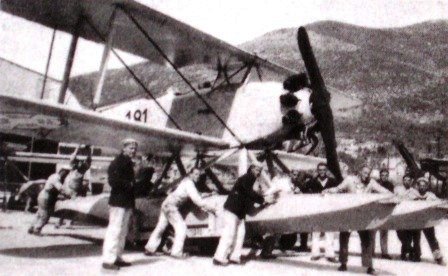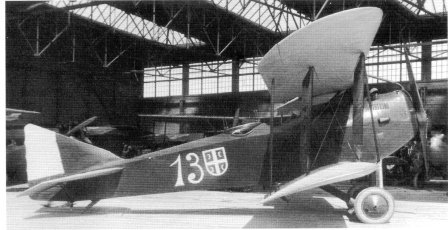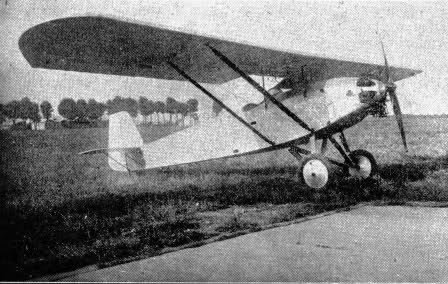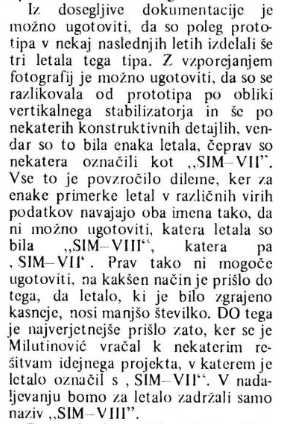I know that there are some confusions about who built and who designed what. For instance, Ik1 and IK2 were designed and built in Ikarus but Ik3 was built in Rogožarski plant. Out of five Yugoslav aircraft plants, four were in close proximity to each other, built in and around Belgrade: Ikarus, Rogožarski, Zmaj and Utva. The fifth one was DFA (Državna Fabrika Aviona - State Aircraft Factory) which was located in Kraljevo. The production series were small compared to larger countries and factories shared orders (for instance Ikarus and Zmaj shared the order for the production of Hurricane MK1).
Here's the list of Rogožarski's projects (Fizir models were designed by Croatian designer Rudi Fizir)
Fizir-Maybach - school (32 units, built from 1927 until 1929.)
Fizir Loren - school (one prototype,1928.)
Fizir Hispano - school / scout (one prototype 1928)
Fizir-Wright - school (one prototype 1930)
Fizir f1g-Kastor - school (one prototype 1931)
Fizir f1g-Titan - school (one prototype 1931)
SIM-VIII - sports travel airplane (3 planes, 1931)
Rogožarski AŽR - school transition aircraft (one prototype, 1934)
Rogožarski PVT - (abbreviation for Interim Aviation Technical) school-fighter aircraft (61 copies, 1935 -1941)
Fizir FN - school (40 copies, 1935.)
Rogožarski SIM-VI - sports and tourism (2 prototypes, 1936 and 1937)
Rogožarski PVT-H - interim school seaplane (1 converted PVT craft and 3 units built, 1937)
Rogožarski SIM-X - a school single-engine two-seater plane for the initial training (21 units, 1937)
Rogožarski SEA-JEEP - modification of SIM X with Gypsy Major engine (1 converted SIM-X, 1940)
Rogožarski SEA-JEEP - modified SIM-X plane for a school night flying (1 converted SIM-X 1941)
Rogožarski IK-3 - single-seater fighter (1 prototype 1937)
Rogožarski IK-3 - single-seater fighter (12 copies - serial production in 1940)
Rogožarski R-100 - single-engine aircraft, single seat for pilot training (26 copies, 1938 and 1939)
Rogožarski SIM XI - acrobatic plane, single seater designed for the training of fighter pilots (1 prototype 1938)
Rogožarski SIM-XII-H - school seaplane (4 prototypes, 4 copies in 1938 and 4 copies in 1940)
Rogožarski SIM-XIV-H - coastal scout (one prototype in 1938 and 6 copies in 1939)
Rogožarski SIM XIVB-H - bomber seaplane (12 copies in 1940)
Rogožarski Brucoš (Freshman) - school aircraft (1 prototype, 1940)
Rogožarski R-313 (originally called SIM-XV) - multi-purpose fighter-destroyer (1 prototype,1940)
Here's the list of Rogožarski's projects (Fizir models were designed by Croatian designer Rudi Fizir)
Fizir-Maybach - school (32 units, built from 1927 until 1929.)
Fizir Loren - school (one prototype,1928.)
Fizir Hispano - school / scout (one prototype 1928)
Fizir-Wright - school (one prototype 1930)
Fizir f1g-Kastor - school (one prototype 1931)
Fizir f1g-Titan - school (one prototype 1931)
SIM-VIII - sports travel airplane (3 planes, 1931)
Rogožarski AŽR - school transition aircraft (one prototype, 1934)
Rogožarski PVT - (abbreviation for Interim Aviation Technical) school-fighter aircraft (61 copies, 1935 -1941)
Fizir FN - school (40 copies, 1935.)
Rogožarski SIM-VI - sports and tourism (2 prototypes, 1936 and 1937)
Rogožarski PVT-H - interim school seaplane (1 converted PVT craft and 3 units built, 1937)
Rogožarski SIM-X - a school single-engine two-seater plane for the initial training (21 units, 1937)
Rogožarski SEA-JEEP - modification of SIM X with Gypsy Major engine (1 converted SIM-X, 1940)
Rogožarski SEA-JEEP - modified SIM-X plane for a school night flying (1 converted SIM-X 1941)
Rogožarski IK-3 - single-seater fighter (1 prototype 1937)
Rogožarski IK-3 - single-seater fighter (12 copies - serial production in 1940)
Rogožarski R-100 - single-engine aircraft, single seat for pilot training (26 copies, 1938 and 1939)
Rogožarski SIM XI - acrobatic plane, single seater designed for the training of fighter pilots (1 prototype 1938)
Rogožarski SIM-XII-H - school seaplane (4 prototypes, 4 copies in 1938 and 4 copies in 1940)
Rogožarski SIM-XIV-H - coastal scout (one prototype in 1938 and 6 copies in 1939)
Rogožarski SIM XIVB-H - bomber seaplane (12 copies in 1940)
Rogožarski Brucoš (Freshman) - school aircraft (1 prototype, 1940)
Rogožarski R-313 (originally called SIM-XV) - multi-purpose fighter-destroyer (1 prototype,1940)







